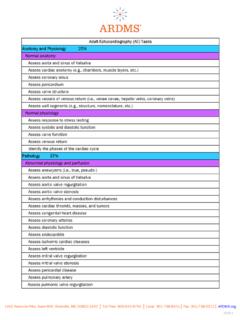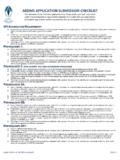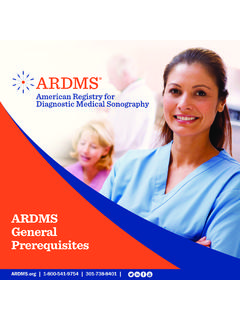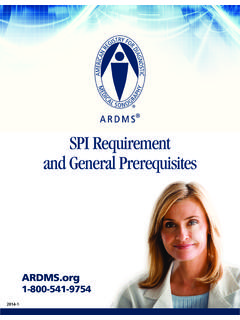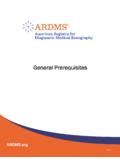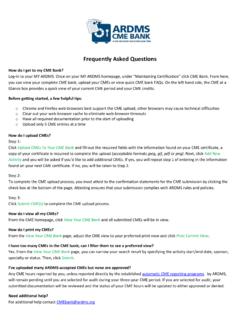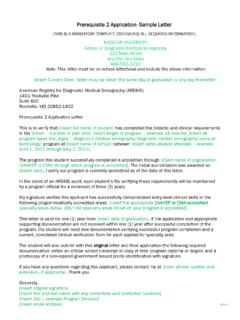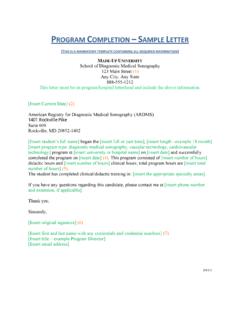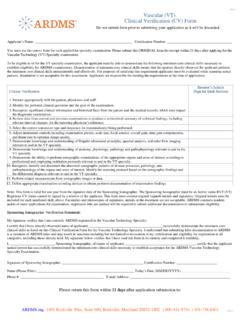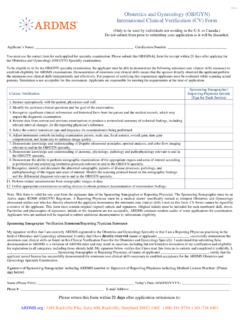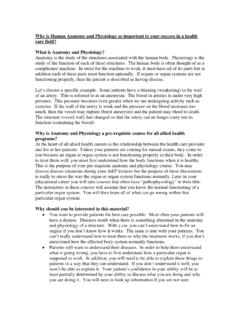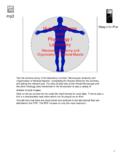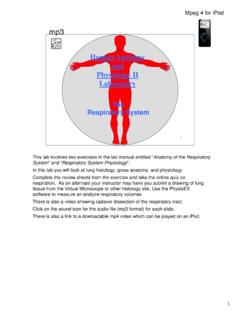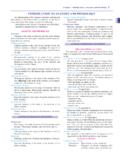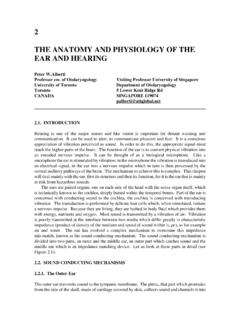Transcription of GYN) Outline Anatomy and Physiology 25% Normal …
1 Obstetrics & Gynecology (OB\GYN) OutlineAnatomy and Physiology 25% Normal Anatomy and PhysiologyGYNA ssess both adnexa ( , ovaries, fallopian tubes)Assess the endometriumAssess the uterus ( , position, orientation, contour)Assess the cervixAssess the cul-de-sacsAssess patients of reproductive ageAssess postmenopausal patientsAssess premenarcheal patientsOBIdentify structures in the first trimester obstetrical exam at less than 10 weeks ( , decidual reaction, gestational sac, yolk sac, embryo)Identify fetal Anatomy in the first trimester obstetrical exam at 10-14 weeks ( , calvarium, stomach, cord insertion, extremities)Identify multiple gestations ( , fetal number, chorionicity/amnionicity)Assess the placenta ( , size, location)Assess the umbilical cord ( , insertion into placenta, vessel number)Assess amnionic fluid volumeAssess fetal lie and presentationAssess the fetal heart ( , axis, chambers, outflow tracts)Assess the neckAssess intracranial structuresAssess the facial Anatomy ( , nose, lips, nasal bones, orbits, profile)Assess the diaphragmAssess the thorax ( , thymus, lungs)
2 Assess the abdomen ( , gallbladder, stomach, liver)Assess the skeletal system ( , cranial contour, long bones evaluation, ribs, vertebrae, skull, spine)Assess the ankles and feetAssess the hands/fingersAssess the genitaliaPathology 41%Abnormal Physiology and PerfusionGYNI dentify adnexal pathology other than ovarianIdentify ovarian pathologyIdentify endometrial pathology ( , polyps, hyperplasia)Identify uterine masses ( , leiomyomas, sarcomas)Identify M llerian duct developmental anomalies ( , septated, subseptate, bicornuate, unicornis uterus)Identify adenomyosisIdentify cervical pathology ( , polyps)Identify free fluid in the pelvisIdentify vaginal pathology ( , imperforated hymen)OBIdentify maternal pelvic pathologyCongenital AnomaliesAssess multiple gestations ( , conjoined twins, acardiac twin, twin to twin transfusion syndrome, discordance)Identify abnormal multiple gestationsIdentify molar degenerationIdentify ectopic pregnancyIdentify embryonic/fetal demiseIdentify anembryonic pregnancyIdentify abnormal trisomy ( , 13, 18, 21)
3 Identify abnormal congenital anomaliesIdentify abnormal amniotic fluid volumeIdentify abnormal fetal growthIdentify abnormal yolk sacIdentify abnormal central nervous system anomaly ( , anencephaly, acrania, hydranencephaly, Dandy-Walker malformation, encephalocele)Identify abnormal intracranial structures ( , choroid plexus cyst)Identify a thickened nuchal translucencyIdentify abnormal face ( , nose/ lips, orbits, profile)Identify abnormal neck ( , goiter, cystic hygroma)Identify abnormal fetal heart ( , axis, chambers, outflow tracts)Identify abnormal diaphragmPage 2 Obstetrics & Gynecology (OB\GYN) OutlineIdentify abnormal thoraxIdentify abnormal abdomen ( , gallbladder, stomach, liver)Identify abnormal abdominal wall defect ( , omphalocele, gastroschisis)Identify abnormal umbilical cord ( , insertion, vessels)Identify abnormal gastrointestinal system ( , echogenic bowel, duodenal atresia, bowel obstruction, esophageal atresia, cysts)Identify abnormal genitourinary system ( , hydronephrosis, cystic renal dysplasia, hydroureter, renal agenesis, bladder outlet obstruction, ureterocele, abnormal genitalia, ovarian cyst)Identify abnormal genitaliaIdentify abnormal skeletal system ( , skull, spine)
4 Identify abnormal ankles and feet ( , club feet, polydactyly)Identify abnormal hands/fingersPlacental AbnormalitiesIdentify previaIdentify vasa previaIdentify subchorionic hemorrhageIdentify abruptionIdentify accreta, increta, percretaIdentify infarctionIdentify abnormal membrane/insertion shape ( , circumvallate)Identify accessory lobeIdentify masses ( , chorioangioma)Protocols 25%Clinical Standards and GuidelinesObtain pertinent clinical history as a part of the examCorrelate previous examsReview lab results as a part of the exam ( , hCG levels, CA 125)Perform quality assurance checks on the equipmentPerform transabdominal techniquePerform transvaginal techniquePerform translabial techniqueMeasurement TechniquesGYNM easure endometrium thicknessMeasure ovarian dimensionsMeasure uterine dimensionsMeasure cervical lengthOBPerform biophysical profilesMeasure amniotic fluid ( , amniotic fluid index, deepest pocket)
5 Measure crown rump lengthMeasure mean sac diameterMeasure the yolk sacMeasure biparietal diameterMeasure biparietal diameter correctedMeasure head circumferenceMeasure cisterna magnumMeasure cerebellumMeasure transverse cerebellar diameterMeasure cerebral lateral ventricleMeasure cephalic indexMeasure nuchal translucency in first trimesterMeasure nuchal fold between 15 and 20 weeks' gestationMeasure orbital, intraorbital and outer orbital diametersMeasure nasal boneMeasure abdomen circumferenceMeasure humerus lengthMeasure femur lengthMeasure other long bones ( , radius, ulna, tibia)Physics and Instrumentation 8%HemodynamicsGYNA ssess ovarian vasculature with DopplerAssess the uterine arteries with DopplerAssess arteriovenous malformations using DopplerOBPage 3 Obstetrics & Gynecology (OB\GYN) OutlineAssess embryonic and/or fetal heart rate and rhythm with M-modeAssess the middle cerebral artery with DopplerAssess the ductus venosusAssess fetal heart rate using DopplerAssess the umbilical cord vessels with DopplerImaging InstrumentsApply M-modeApply color flow imagingApply power (angio, amplitude)
6 DopplerApply pulsed spectral DopplerApply harmonicsPerform 3-D imagingApply knowledge of artifactsTreatment 1%Sonographer Role in ProceduresProvide guidance for sonohysterographyProvide guidance for amniocentesis after 15 weeksProvide guidance for chorionic villus samplingwww. Rockville Pike Suite 600 Rockville, Maryland 20852 Phone: 301-738-8401 Toll Free: 800-541-9754 Fax: 301-738-0312
